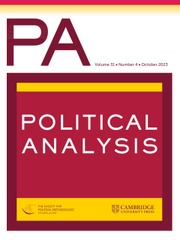Article contents
Specification Issues in Proximity Models of Candidate Evaluation (with Issue Importance)
Published online by Cambridge University Press: 04 January 2017
Abstract
The use of the proximity model to represent the relationship between citizens' policy attitudes and the positions of candidates on the issues of the day has considerable appeal because it offers a bridge between theoretical models of political behavior and empirical work. However, there is little consensus among applied researchers about the appropriate representation of voter behavior with respect to the measurement of issue distance, candidate location, or whether to allow heterogeneity in the weight that each individual places on particular issues. Each of these choices suggests a different, and reasonably complicated, nonlinear relationship between voter utility and candidate and voter issue positions which may have a meaningful influence on the substantive conclusions drawn by the researcher. Yet, little attention has been given to the best way to represent the proximity model in applied work. The purpose of this paper is to identify which forms of the proximity model work best, with particular consideration given to the identification of functional forms that are invariant to the choice of scale for the independent variables.
Information
- Type
- Research Article
- Information
- Copyright
- Copyright © The Author 2006. Published by Oxford University Press on behalf of the Society for Political Methodology
Footnotes
Authors' note: We thank the anonymous reviewers at Political Analysis for helpful comments on this paper. Data for this project are provided by the Inter-University Consortium for Political and Social Research. Supplementary materials and data are available on the Political Analysis Web site.
References
- 37
- Cited by

